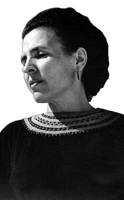
|
The Society of Folk Dance Historians (SFDH) Sara Levi-Tanai
[
Home |
About |
Encyclopedia | CLICK AN IMAGE TO ENLARGE |

|
BACKGROUND
Information: Sara Levi-Tanai, teacher of Israeli dance.
Sara Levi-Tanai was born in Jerusalem in 1911 to parents who had come from Yemen in the 1880s. They moved to Jerusalem during the era of the Ottoman reign and under the Turks there were no official birth certificates. When Sara was about four years old, her mother died. Her father, who had severe alcohol problems, abandoned his daughter to her fate and she was raised in an orphanage in the Galilee by teachers from Europe.
In 1949, one year after the foundation of the independent State of Israel, she met with her true destiny. She encountered a group of youngsters who had just arrived from Yemen to settle in Israel and began teaching them Israeli songs and dances. Her students were exceptionally gifted boys and girls and from them she learned many aspects of the Yemenite-Jewish traditions. Sara began experimenting with the traditional Yemenite dance steps, rhythms, and melodies that were her students' expertise.
She particularly noted a stepping pattern they referred to as the Da'asa, swaying the torso and hips gently forward and back, progressing counter-clockwise. For Sara Levi-Tanai, the Da'asa became symbolic of walking in the desert, of caravans, of the wide empty spaces that she so loved. She utilized this and other folkloric traditional patterns in many variations in her choreographies.
When Sara became a student at the Levinsky Teachers Seminar in Tel Aviv in her late teens, she went to visit the Yemenite quarter, Kerem Hateymanim. There she heard and saw Yemenite song and dance and encountered the rich artistic heritage of her ancestors.
She was concerned with a total experience and her dancers, especially in the beginning, sang and drummed as well as danced, thereby affecting their audiences in very strong ways.
When Sara Levi-Tanai worked as a kindergarten teacher at Kibbutz Ramat Hakovesh during World War II, she composed songs and dances such as her winning El Ginat Egoz ("to the walnut grove"). This has become a classic of both Israeli folk song and dance.
In 1950, she founded the Inbal Dance Theatre. In 1952, Jerome Robbins came to Israel to report on the dance scene for the Norman Fund's American Fund for Israeli Institutes, and was introduced to Sara and her work. Robbins found her choreography brilliant, original, and unique, and called the mainly vertical dance movement of the Yemenite men "Yemenite Gothic." Robbins suggested to the impresario Sol Hurok that her Inbal troupe be brought on tour to America.
In 1956-57 Hurok sponsored Inbal on its first tour of the United States and Europe. The critics and the audiences there and in Western Europe were enthusiastic, captivated by the bearded men and the lithe women who accompanied their dance with singing and the playing of drums.
In 1991 she was ousted as artistic director of Inbal, and the company was eventually made part of a larger organization, the Inbal Interdisciplinary Ethnic Center. Sara then toured with a program, "Who Kissed Me," in which she joined two singer-dancers as a narrator. She was the subject of a documentary, "Bare Feet."
She created over 40 dances for Inbal. Like many great artists, Sara tenaciously resisted any attempt to recreate or restage her choreography. Only in 1996, when she had become director emeritus of Inbal, were dances successfully re-staged by veteran Inbal dancers including Lea Avraham and Ilana Cohen, who has been Inbal's artistic director since 1997.
Sara Levi-Tanai died Oct. 3, 2005, in Ramat Gan, Israel. She was 94. She is survived by a daughter, Michal, and a son, Yaacov, and several grandchildren and great grandchildren.
Dances Sara taught include Ana Pana Dodech, Chag Purim, El Ginat Egoz, Hanoded, Hanukah O Hanukah, Harishut II, Ken Yovdu, Ki Tavo-u el Ha'aretz, Kol Dodi, Lanu Hakoach, Shibolet Basadeh, Shualim Ketanim, and Tedrechi.
This page © 2018 by Ron Houston.
Please do not copy any part of this page without including this copyright notice.
Please do not copy small portions out of context.
Please do not copy large portions without permission from Ron Houston.